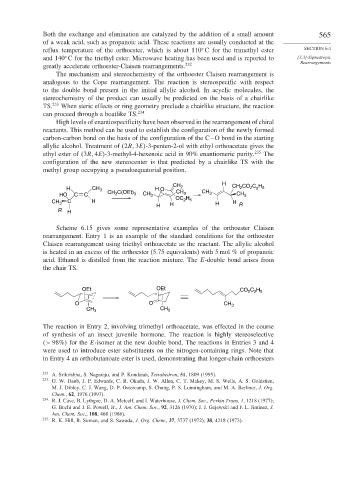Page 591 - Advanced Organic Chemistry Part B - Reactions & Synthesis
P. 591
Both the exchange and elimination are catalyzed by the addition of a small amount 565
of a weak acid, such as propanoic acid. These reactions are usually conducted at the
reflux temperature of the orthoester, which is about 110 C for the trimethyl ester SECTION 6.4
and 140 C for the triethyl ester. Microwave heating has been used and is reported to [3,3]-Sigmatropic
Rearrangements
greatly accelerate orthoester-Claisen rearrangements. 232
The mechanism and stereochemistry of the orthoester Claisen rearrangement is
analogous to the Cope rearrangement. The reaction is stereospecific with respect
to the double bond present in the initial allylic alcohol. In acyclic molecules, the
stereochemistry of the product can usually be predicted on the basis of a chairlike
TS. 233 When steric effects or ring geometry preclude a chairlike structure, the reaction
can proceed through a boatlike TS. 234
High levels of enantiospecificity have been observed in the rearrangement of chiral
reactants. This method can be used to establish the configuration of the newly formed
carbon-carbon bond on the basis of the configuration of the C−O bond in the starting
allylic alcohol. Treatment of 2R 3E -3-penten-2-ol with ethyl orthoacetate gives the
ethyl ester of 3R 4E -3-methyl-4-hexenoic acid in 90% enantiomeric purity. 235 The
configuration of the new stereocenter is that predicted by a chairlike TS with the
methyl group occupying a pseudoequatorial position.
CH H CH CO C H
H CH 3 H O 2 2 2 2 5
HO C C CH C(OEt) 3 CH 3 CH 3 CH 3 CH 3
3
2 5
CH 3 C H OC H H H
H H R
R H
Scheme 6.15 gives some representative examples of the orthoester Claisen
rearrangement. Entry 1 is an example of the standard conditions for the orthoester
Claisen rearrangement using triethyl orthoacetate as the reactant. The allylic alcohol
is heated in an excess of the orthoester (5.75 equivalents) with 5 mol % of propanoic
acid. Ethanol is distilled from the reaction mixture. The E-double bond arises from
the chair TS.
OEt OEt CO C H
2 2 5
O O CH 3
CH
CH 3 3
The reaction in Entry 2, involving trimethyl orthoacetate, was effected in the course
of synthesis of an insect juvenile hormone. The reaction is highly stereoselective
> 98% for the E-isomer at the new double bond. The reactions in Entries 3 and 4
were used to introduce ester substituents on the nitrogen-containing rings. Note that
in Entry 4 an orthobutanoate ester is used, demonstrating that longer-chain orthoesters
232 A. Srikrishna, S. Nagaraju, and P. Kondaiah, Tetrahedron, 51, 1809 (1995).
233
G. W. Daub, J. P. Edwards, C. R. Okada, J. W. Allen, C. T. Makey, M. S. Wells, A. S. Goldstien,
M. J. Dibley, C. J. Wang, D. P. Ostercamp, S. Chung, P. S. Lunningham, and M. A. Berliner, J. Org.
Chem., 62, 1976 (1997).
234 R. J. Cave, B. Lythgoe, D. A. Metcalf, and I. Waterhouse, J. Chem. Soc., Perkin Trans. 1, 1218 (1977);
G. Buchi and J. E. Powell, Jr., J. Am. Chem. Soc., 92, 3126 (1970); J. J. Gajewski and J. L. Jiminez, J.
Am. Chem. Soc., 108, 468 (1986).
235
R. K. Hill, R. Soman, and S. Sawada, J. Org. Chem., 37, 3737 (1972); 38, 4218 (1973).

